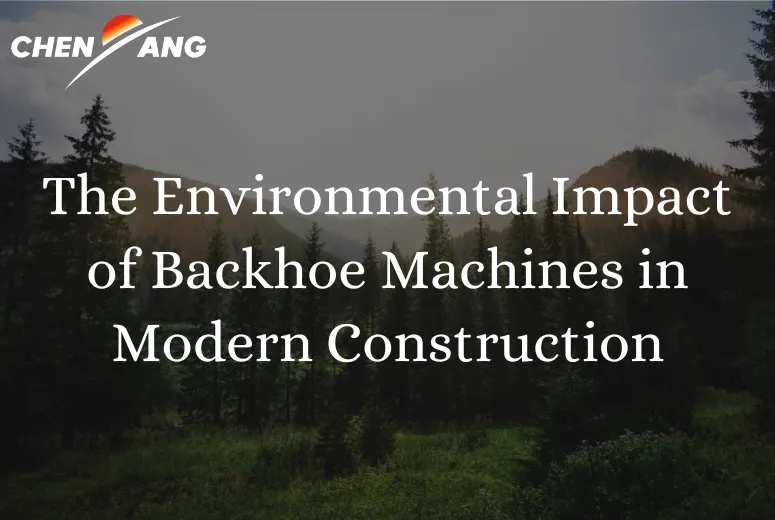The Environmental Impact of Backhoe Machines in Modern Construction
Backhoe machines have become an indispensable tool in modern construction, facilitating tasks like digging, lifting, and material handling. However, their widespread use comes with significant environmental considerations. As the construction industry moves towards more sustainable practices, understanding the environmental impact of backhoe machines is crucial for minimizing their ecological footprint. This article explores the environmental challenges posed by these machines and how the industry is responding with greener alternatives and practices.

Fuel Consumption and Emissions About Backhoe Machine
One of the most significant environmental impacts of backhoe construction equipment is their fuel consumption and the resulting emissions. Most backhoes are powered by diesel engines, which, while providing ample power for heavy-duty tasks, also emit a range of pollutants, including carbon dioxide (CO2), nitrogen oxides (NOx), and particulate matter. These emissions contribute to air pollution, greenhouse gas accumulation, and climate change.
The construction sector, known for its energy-intensive operations, is a major source of diesel consumption. Backhoe loader for tractor are often in operation for long hours, exacerbating their fuel usage and emission levels. Though modern engines are more fuel-efficient than their predecessors, the environmental impact remains a concern, especially on large-scale projects that require continuous operation of multiple machines.
Noise Pollution of Backhoe Machine
In addition to air pollution, backhoe machines also generate substantial noise, particularly in urban or residential areas. The loud operation of these machines can lead to noise pollution, which has been shown to affect the health and well-being of nearby communities. Prolonged exposure to high noise levels can contribute to stress, hearing loss, and disturbed sleep patterns for those living and working in proximity to construction sites.
The construction industry is aware of the noise impact, and manufacturers are increasingly designing quieter backhoe machines, equipped with noise-reducing technologies like sound-insulated engine covers and improved exhaust systems. However, noise remains a challenge, especially in densely populated areas where construction projects often occur.
Soil Disturbance and Habitat Disruption of Backhoe Machine
Backhoe machines, by their nature, are designed to disturb the earth. Excavation and digging are core functions, but this can result in significant soil disturbance and disruption of local habitats. Soil erosion, compaction, and displacement of vegetation are common consequences of backhoe operations, particularly in sensitive areas like wetlands or natural reserves.
These activities can have cascading effects on local ecosystems, disrupting biodiversity and hydrological systems. For example, erosion can lead to sediment runoff into nearby water bodies, affecting water quality and aquatic life. While construction companies typically follow environmental guidelines to reduce such impacts, the reality is that backhoe use in certain areas can still lead to irreversible damage to the landscape.
Fuel-Efficient Alternatives and Hybrid Models of Backhoe Machine
To address the environmental impact of backhoe machines, manufacturers are developing more fuel-efficient and environmentally friendly models. One of the most promising innovations is the hybrid backhoe loader, which combines traditional diesel power with electric or battery-operated systems. These hybrid models are designed to reduce fuel consumption, lower emissions, and decrease the overall carbon footprint of construction projects.
Hybrid backhoes can significantly reduce fuel usage, especially in urban construction sites where the machine’s load and power requirements vary throughout the day. By leveraging electric power during low-demand periods, these machines offer a more sustainable alternative to traditional diesel-only models. Although the initial cost of hybrid backhoes may be higher, their long-term savings in fuel and maintenance costs make them an attractive option for construction companies committed to sustainability.
The Role of Telematics and Fleet Management About Backhoe Machine
Telematics, or remote monitoring systems, are increasingly being integrated into backhoe machines to enhance fuel efficiency and reduce their environmental impact. These systems track a variety of metrics, including fuel consumption, idle time, and engine performance, enabling construction managers to optimize machine usage and ensure that backhoes are operating at peak efficiency.
By utilizing telematics, companies can minimize fuel waste and reduce emissions by ensuring that machines are not idling unnecessarily. Furthermore, telematics can help monitor maintenance schedules, ensuring that backhoes are running efficiently and are less likely to break down or operate inefficiently. This not only reduces environmental harm but also improves the longevity and cost-effectiveness of the equipment.
Recycling and Disposal of Construction Materials About Backhoe Machine
Another aspect of the environmental impact of backhoe machines relates to the disposal and recycling of materials excavated during construction projects. While backhoe machines are primarily used for digging and material handling, the excavation process often generates waste that needs to be managed responsibly. Waste materials, such as soil, rock, and debris, can be harmful to the environment if not properly disposed of or recycled.
Many construction companies are now implementing waste reduction practices, such as sorting and recycling excavated materials. For example, soil can be repurposed for landscaping or erosion control, and concrete debris can be crushed and used as aggregate for new construction projects. In this way, backhoe machines can indirectly support sustainable construction practices by aiding in the responsible management of waste materials.
-
Low Maintenance + High Availability of Ownership for Mining Dump TruckNewsJul.17,2025
-
Drum Drive Axle + Air Suspension for Electric Tractor TruckNewsJul.17,2025
-
33m Boom + Full Hydraulic Outriggers: Narrow-Site Construction Practices of Mixer Pump TruckNewsJul.17,2025
-
18L Large Drum + Extended Drain Interval of Gear Oil for Heavy Duty TrucksNewsJul.17,2025
-
13m Cargo Space + Polyurethane Insulation: Long-Term Cold Chain Protection Solutions for Refrigerated Semi-Trailers for SaleNewsJul.17,2025
-
10T Water Tank + 2.5MPa Fire Pump Efficiency Analysis of Water Tank Fire TruckNewsJul.17,2025
Popular products

























